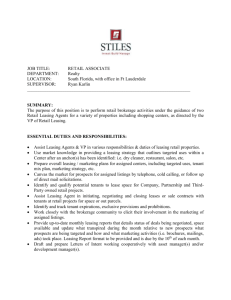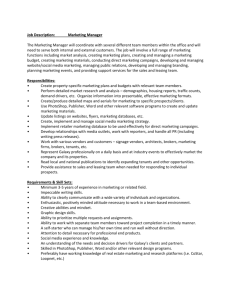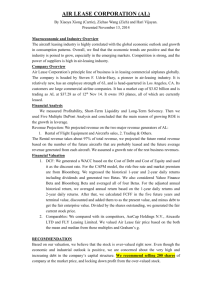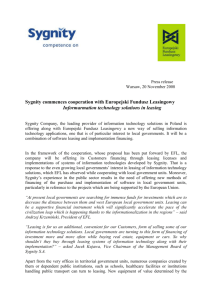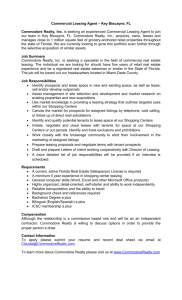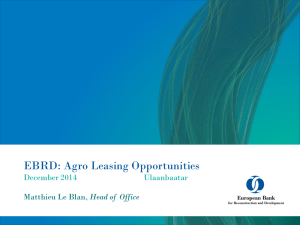The story of asset-based finance & leasing in Canada
advertisement
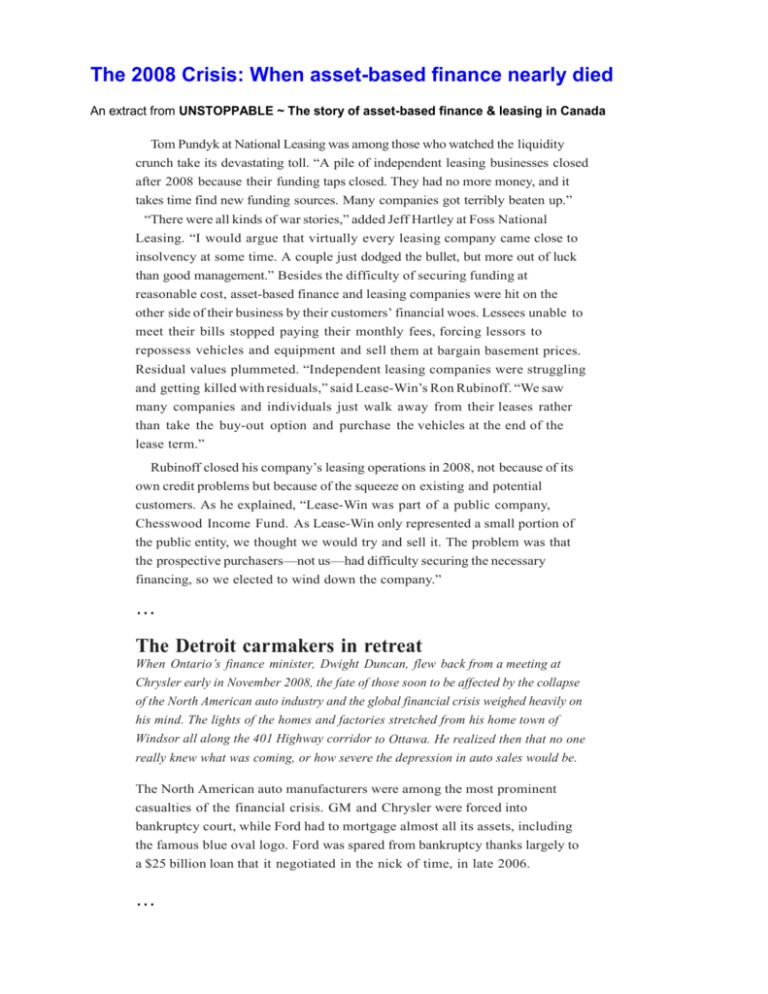
The 2008 Crisis: When asset-based finance nearly died An extract from UNSTOPPABLE ~ The story of asset-based finance & leasing in Canada Tom Pundyk at National Leasing was among those who watched the liquidity crunch take its devastating toll. “A pile of independent leasing businesses closed after 2008 because their funding taps closed. They had no more money, and it takes time find new funding sources. Many companies got terribly beaten up.” “There were all kinds of war stories,” added Jeff Hartley at Foss National Leasing. “I would argue that virtually every leasing company came close to insolvency at some time. A couple just dodged the bullet, but more out of luck than good management.” Besides the difficulty of securing funding at reasonable cost, asset-based finance and leasing companies were hit on the other side of their business by their customers’ financial woes. Lessees unable to meet their bills stopped paying their monthly fees, forcing lessors to repossess vehicles and equipment and sell them at bargain basement prices. Residual values plummeted. “Independent leasing companies were struggling and getting killed with residuals,” said Lease-Win’s Ron Rubinoff. “We saw many companies and individuals just walk away from their leases rather than take the buy-out option and purchase the vehicles at the end of the lease term.” Rubinoff closed his company’s leasing operations in 2008, not because of its own credit problems but because of the squeeze on existing and potential customers. As he explained, “Lease-Win was part of a public company, Chesswood Income Fund. As Lease-Win only represented a small portion of the public entity, we thought we would try and sell it. The problem was that the prospective purchasers—not us—had difficulty securing the necessary financing, so we elected to wind down the company.” … The Detroit carmakers in retreat When Ontario’s finance minister, Dwight Duncan, flew back from a meeting at Chrysler early in November 2008, the fate of those soon to be affected by the collapse of the North American auto industry and the global financial crisis weighed heavily on his mind. The lights of the homes and factories stretched from his home town of Windsor all along the 401 Highway corridor to Ottawa. He realized then that no one really knew what was coming, or how severe the depression in auto sales would be. The North American auto manufacturers were among the most prominent casualties of the financial crisis. GM and Chrysler were forced into bankruptcy court, while Ford had to mortgage almost all its assets, including the famous blue oval logo. Ford was spared from bankruptcy thanks largely to a $25 billion loan that it negotiated in the nick of time, in late 2006. … All the carmakers were hit by the loss of confidence in the asset-backed securities market, where their financing arms typically resold their lease portfolios. “The credit crisis froze the asset-based paper market, which is how most of the funders in the leasing space in Canada financed their business,” explained Peter Andrew. “There was an immediate effect because of the trouble faced by automobile manufacturers.” GM, Ford, and Chrysler were among the United States’ biggest corporations, and their troubles sent ripples of anxiety through the banking system. Banks became increasingly nervous about their loans to automakers, so the automakers that depended on banks for credit had no choice but to set aside hundreds of millions of dollars in provisions to cover their obligations. In 2006, GM was forced to sell 51 percent of its GMAC financial services arm to Cerberus Capital Management, a private equity firm. Cerberus also bought Chrysler Financial a year later. Larry Baldesarra, president of Toyota Financial Services Canada, pointed out that the plight of the Detroit captives stemmed from the troubles of the parent companies rather than the captives themselves. “These were very good companies,” said Baldesarra. “I knew them well; they were well managed, with good people.” … Consumer leasing gives way to loans A combination of the carmakers’ troubles and heightened risk aversion among lenders brought consumer vehicle leasing to a virtual standstill. In August 2008, Chrysler Financial announced it was getting out of leasing. Ford Motor Credit and then GMAC said shortly afterwards that they were “scaling back.” Tightened terms and higher monthly payments meant that, to all intents and purposes, their leasing business also ground to a halt. Similarly, most foreign carmakers were forced to cut back their lease programs due to prohibitively high funding costs. Ford Credit’s Primus Financial Services division, set up to ser- vice the import brands, stopped offering leases. Ford Credit also ended its affiliation with Mazda, leaving the Japan-based automaker without a lease program. … Crisis of confidence Through the fall of 2008 and into 2009, it was clear to policy-makers and analysts that the Canadian economy was set for a long period of stagnation unless ways could be found to get credit flowing again. Rob Wright, then the deputy minister of finance, noted that banks and credit unions had provided conventional lending of $271 billion, or only 24 percent, of the $1.125 trillion in outstanding business credit in Canada in 2007. In other words, more than three-quarters of business credit came from other sources: $306 billion from the equity markets and $458 billion from non-equity 2 financial markets (including an estimate by the Centre of Spatial Economics of up to $100 billion from finance companies and the asset-based finance subsidiaries of the banks and credit unions).84 The banks really were the last man standing. Bond and equity markets essentially closed down, and the other non- bank finance companies had nowhere to go to access funds. The banks stepped up, but not sufficiently to appease all critics. There were segments of the market that complained that they could not get access to funds (at least not from their traditional providers). Some may not have had a strong relationship with banks before the crisis. But once the crisis hit, the banks definitely were not in the mood to take on anything that could be perceived as high risk. The asset-based finance and leasing industry faced a serious challenge. Investors had been unnerved by worthless—often fraudulent—sub-prime real estate mortgages passed off in the United States as legitimate and even blue chip investments. The industry urgently needed to differentiate its sound products from those tainted by the financial crisis. It needed to offer reassurance that equipment and vehicles could back safe and profitable investments. “The equipment and vehicle assets securitized by the asset- backed financing and leasing industry were totally different,” said Angela Armstrong. “Unfortunately we got tarred with the same brush.” David Powell outlined the dilemma facing the industry: “Essentially, securitization as a financing method for both real estate mortgage–backed securities and asset-backed securities was similar, but the quality of the assets secured as collateral was totally different. These were equipment and vehicle assets that were being used and paid for by real customers. The cost and availability of funds in no way reflected the risk that the industry or its business represented. Rather it reflected a sys- tem-wide ‘capital rationing.’ Traditional funders were deploying their cash elsewhere to meet the pressures they were experiencing because of the global crisis.” CFLA takes action The asset-based finance and leasing industry, with the CFLA in the forefront, was determined to step up to the plate and demonstrate that it could be part of the solution. But it faced a particular problem of its own making. In this largely unregulated industry, people had deliberately avoided much contact with governments in the past. As a consequence, most policymakers knew little about the sector, what it did, and how it functioned. The CFLA had a double challenge: first, to educate politicians and government officials on how the industry should be part of the solution to stimulate the recovery and, second, to reassure them that there was minimal risk to taxpayers. Discussions with Finance Department officials revolved around ways to temporarily “replace” private funding for the industry until market confidence returned. For more, read Unstoppable ~ The Story of the asset-based finance and leasing industry in Canada. 3 Unstoppable tells the previously untold story of a business that has grown to be the largest source of debt financing to Canadian companies and consumers outside of traditional banking. This book covers the rollercoaster ride of assetbased finance, now a $300 billion business, through interviews with business trailblazers such as Jim Pattison and Steve Hudson, who led the industry for the past half century. It is an entertaining and personal business history that will inspire both students of Canadian business history and entrepreneurs alike. Unstoppable shows how this form of finance helped to grow Canada’s economy by financing equipment and vehicles of all kinds. It chronicles the rise and fall and rise again of car leasing and the industry’s struggle to stay alive in the depths of several recessions, most recently in 2008-2009. The business not only survived, it thrived, mainly because of the Canadian business leaders who were determined to keep credit flowing, even in the worst of times. Beth Parker writes for business and organizations in Canada and the United States. Her clients range from Fortune 500 companies to start-up entrepreneurs. Beth has an English degree from the University of Toronto (Victoria College) and an MA in journalism from the University of Western Ontario. RELEASED: September 2014 Published by Barlow Books Available in hardcover and ebook formats from Amazon.ca Price: $16.37 (print); $9.99 (ebook) The untold story of how entrepreneurs created a new type of finance in Canada Reviews “Unstoppable is a pioneering look into a vital sector of Canada’s economy. It tells of entrepreneurs: their visions, setbacks and successes. It documents booms and busts, risks and rewards, as leasing expanded with many of Canada’s most dynamic businesses. And it reveals asset-based finance’s importance to the investments that drive growth and support Canadians’ quality of life.” William B.P. Robson, President and CEO, C.D. Howe Institute “Despite the rocky 2008-9 period that witnessed a major reduction in asset-backed financing and leasing in Canada, the industry has thundered ahead with over $300 billion in transactions today. It is for good reason why this industry is “unstoppable” but to find out, read this well put-together history. It is a very enjoyable review of an industry that is should be understood by any one working in finance.” Dr. Jack M. Mintz, Palmer Chair of Public Policy, and Director of the School of Public Policy, University of Calgary “Unstoppable tells the story of asset-based finance and leasing in Canada an often ignored but a important part of the Canadian financial system. From the earliest beginnings the subsector has made the financing of vehicles, office equipment as well as specialized equipment more efficient. This is a notable contribution to our understanding not only of asset based financing but of the whole financial system.” Joe Martin, Director of Canadian Business and Financial History, Rotman School of Management, University of Toronto To learn more about the people and products that built the industry and moved it to success, read Unstoppable ~ The Story of the asset-based finance and leasing industry in Canada.


